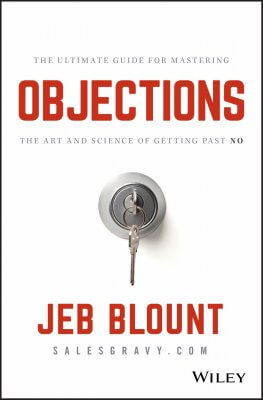Sales Masterclass: How To Avoid Triggering The Negativity Bias
Business buyers are naturally sceptical, so don't reinforce negative preconceptions.

Despite the almost universal perception that salespeople will say or do anything to get the deal, I rarely meet salespeople who harbour ill intentions. Most sales professionals:
- Want the best for their prospects.
- Do the right thing.
- Keep their promises.
- Tell the truth.
- Believe in what they are selling.
The trap salespeople fall into though is the false belief that good intentions are enough. Stakeholders are not judging your trustworthiness based on your intentions. Instead, they judge you based on their intentions.
In our hypercompetitive global marketplace, dominated by disruptive change, there is very little tolerance for failure in the workplace, and the penalties for making mistakes can be severe. Buying a new product or switching vendors carries real risk for stakeholders.
Fear, insecurity, lack of trust, misunderstanding, dislike, and uncertainty are the genesis of resistance and objections. When stakeholders rely on you to deliver on promises, they put themselves in a vulnerable position.
Should you fail to perform, the impact on their business, company, career, finances, or family could be extreme.
This, by the way, is why making no change—sticking with the status quo—is often the emotionally safe choice, even when staying put is illogical or dysfunctional.
Stakeholders are scrutinising you. They are looking for congruence in your words, nonverbal communication, and actions. Your every behaviour, every word, every action is being observed. Humans focus attention on things that stick out, and for humans, anything negative sticks out like a sore thumb.
This is the negativity bias. The human brain is attuned to what’s wrong about someone rather than what is right. Negative things have a greater impact on behaviour than positive things. Negative messages, thoughts, and images grab and hold our attention.
Over time, these small negative perceptions add up, building the case that someone cannot be trusted.
When you lack emotional control, you’ll often introduce objections where they didn’t exist, triggering the negativity bias. Salespeople trigger the negativity bias by:
· Answering unasked questions.
· Discussing what they perceive to be objections even though the prospect hasn’t mentioned the issue.
· Bringing into the current sales conversation objections from another as a way to protect themselves from rejection.
· Projecting objections on their prospects.
· Introducing potentially negative issues or perceptions about their product early in the sales process to “get them on the table.”
· Talking about operational issues and potential service issues out of context.
You trigger the negativity bias when, after asking for a buying commitment, your mouth keeps running instead of shutting up and allowing the stakeholder to respond.
In this moment of insecurity, you overwhelm the buyer with deal terms and conditions, begin pitching features and benefits, bring up negative aspects of your product, or reintroduce an early red herring that the buyer had long forgotten.
Your competitors can also trigger the negativity bias by pointing out flaws in your product, customers they have taken from you, and negative online reviews. As they introduce these issues in sales conversations buyers fixate on them.
Should your competitor keep pounding these falsehoods home it can lead to something called the illusory truth effect. This is the human tendency to believe information that is repeated often, even when it is not true.
This can initiate the frequency illusion, which accentuates the negativity bias. We’ve all experienced this phenomenon. For example, say you are looking for a new car and you get your heart set on a certain model.
Suddenly, you begin noticing this particular model everywhere. When prospects are primed by your competitors with negative things about your company and product, it can likewise amplify their scrutiny, causing them to be more tuned in to seeing these negative patterns.
This is where things can go badly for you. For example, your competitor tells your stakeholder that ABC company ended their relationship with you due to service failures. During a sales call, the stakeholder hits you right between the eyes with a difficult question about this.
You then chase this red herring and try to explain what happened. But because you were caught off guard, it comes off as a defensive argument in which you don’t seem truthful.
This triggers both reactance, which increases resistance and heightens their concerns, and distrust—pushing your stakeholder away from you and towards your competitor.
Once your stakeholder begins to believe your competitor offers a better product, service, or solution than you, they seek out information that supports this belief. This confirmation bias causes them to be drawn to things that confirm their position and ignore contradictory evidence. This is why competitor objections often seem so illogical.
In sales, you are always on stage. You must:
· Exert a tremendous amount of self-control and discipline to manage every behavior, promise, and action while in front of stakeholders.
· Neutralize negative competitors early in the sales process by preframing to stakeholders for exactly what the competitor will say and do.
· Present solid references and case studies that counter and neutralize negative perceptions.
· Avoid self-inflicted injuries by introducing objections and negative perceptions into the sales conversation.
It’s important to find reasons to meet with your prospects and provide them with additional information and insight as often as possible. You must control and keep your message top of mind. This gives you the upper hand and takes advantage of the availability bias.
Humans tend to remember things that are most available and easiest to access in our memory.
The more often you provide positive information about you, your company, products, and services, the more likely your stakeholders are to recall this information, which in turn neutralizes your competitors and reduces objections.
This is an edited extract from Objections: The Ultimate Guide for Mastering the Art and Science of Getting Past No, by Jeb Blount (Wiley, July 2018).

Thanks for signing up to Minutehack alerts.
Brilliant editorials heading your way soon.
Okay, Thanks!

